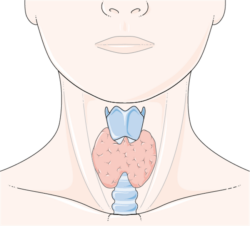Thyroid and Migraine: Which Comes First?
Many people suffer from migraine and thyroid disease, but don’t realize they can be comorbid. This means the two can occur at the same time but are not necessarily caused by one another. There are over 37 million Americans with migraine disease and close to 27 million Americans who have thyroid disease, half of whom are undiagnosed. Because the thyroid gland plays such an important role in the body, when thyroid disease is present, it is reasonable to suspect that thyroid symptoms might trigger migraines. Interestingly, although the message boards and blogs are filled with discussions of migraineurs who come to find they also have a thyroid disorder, there is very little research connecting the two.
Let’s explore the connection between migraine and thyroid
First let’s talk about Migraines. Migraine is a neurological condition with a complex and not yet fully understood, genetic component. It is thought to be caused by overactive neurons in our brains. Researchers are not exactly sure how or why the brain of a person with migraine is unlike those without migraine but they do know a migraine attack is typically triggered by stimuli. Fluctuating hormones, changes in the barometric pressure, dehydration, certain foods and changes in sleeping patterns are a few stimuli that will trigger a migraine for some people; however the list is quite extensive.
Phases of a Migraine
There are four phases of a migraine attack the first of which is called prodrome. Its symptoms include but are not limited to – frequent yawning and urination, feeling anxious and cranky, being tired and some people have food cravings.
The next phase is called aura – symptoms in this phase include blinking and/or flashing lights, squiggly lines, blurred vision, smelling and/or hearing things that aren’t there, feeling dizzy, confused, neck pain and being oversensitive to touch (called allodynia) – your scalp may hurt when you brush your hair – to name just a few.
The headache phase has been considered the most incapacitating because not only does our head fiercely hurt, but we may feel pain in other parts of our body. Migraine pain is often one sided but can change sides or be on both sides of the head. Our neck, jaw, teeth, eyes and cheeks may be painful in addition to nausea, dizziness, light, smell and sound sensitivity. There can also be gastrointestinal issues and horrible anxiety as well as depression during this phase.
Postdrome, the last phase can take a few hours or even days to recuperate from. Some may feel a sense of wellness during postdrome but many report feeling “wrung out.” In addition to these symptoms others include, but are not limited to feelings of depression, excessive tiredness, reduced emotion and an inability to concentrate.
Risk Factors for Migraine
Those who are obese have a five times greater risk of developing migraine and people with depression are at a three times greater risk. Other risk factors include head injury, too much caffeine consumption and being a woman. Similarly, thyroid disease predominantly affects women, often is associated with weight gain and depression (hypothyroid). Other risk factors for thyroid disease include: being over the age of 50 for men and women, a family history of thyroid disease, smoking, being exposed to certain chemicals and medications, being exposed to iodine, or being iodine deficient, radiation, neck injury, certain medications.
If you have migraine plus thyroid issues, what does this mean for you?
The first thing to consider is getting an accurate diagnosis on both fronts – migraine and thyroid. This is no easy task, especially on the thyroid front, as many women go undiagnosed for years. Visit our friends at ThyroidChange for more information.
You must have a complete exam with your doctor, having him/her go over you and your family’s medical history and discuss your symptoms in detail. While blood work is used as a diagnostic tool for thyroid disease, there are no tests at this point for migraine disease. It is diagnosed by meeting criteria, having a complete neurological exam, reviewing you and your family’s medical history and discussing your symptoms.
Having multiple diseases can be a challenge, especially when first diagnosed. No need to panic, get as much information and education as you can and learn about your diseases. If you do have migraine and thyroid disease, getting your thyroid hormones under control may help reduce the susceptibility to some of migraine triggers, thus reducing attacks.
And who doesn’t want fewer migraine attacks?
About the Author
Nancy Bonk is a patient advocate for living with migraine, a regular contributor to Hormones Matter and other online journals.
____________
Resources:
Blackwell J. “Evaluation and treatment of hyperthyroidism and hypothyroidism.” Journal of the American Academy of Nurse Practitioners.” 2004;16:422–425.
EMedicine Health. “Thyroid Problems.” WebMD LLC. January 4, 2013.
Shoman, M. “What is the Thyroid?” About.Com. January 3, 20123
Shoman, M. “Risk Factors for Thyroid Disease.” About.Com. January 3, 2013.
Press Release. “News from the 31st Annual Scientific Meeting of the American Pain Society: Risk Factor Management Helps Prevent Migraine Attacks.” Honolulu. Hawaii. May 17, 2012. http://www.americanpainsociety.org/about-aps/content/aps-risk-factor-management-helps-prevent-migraine-attacks.html











